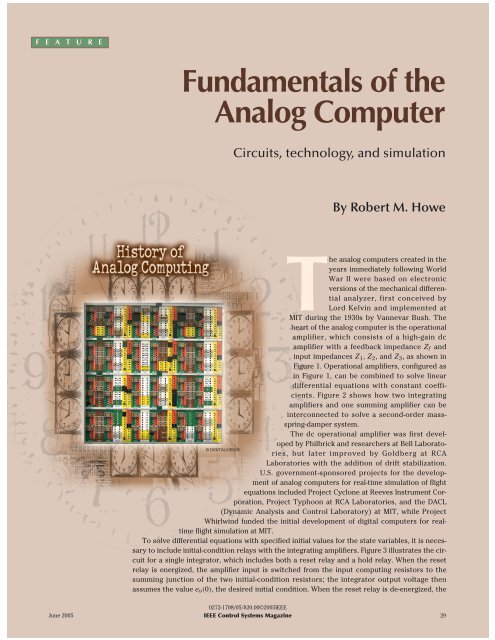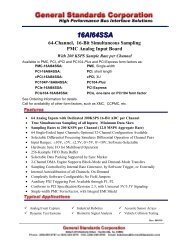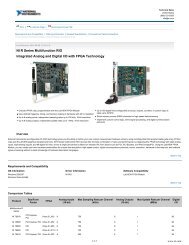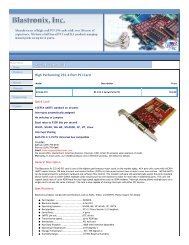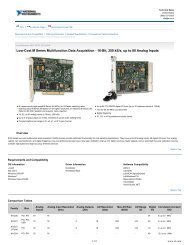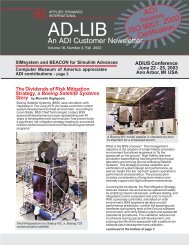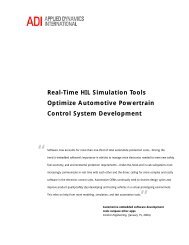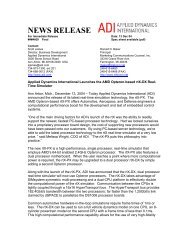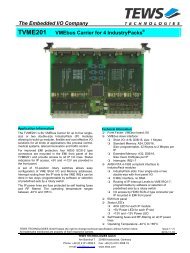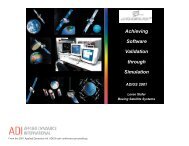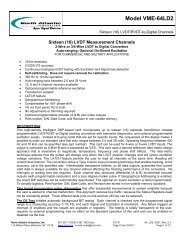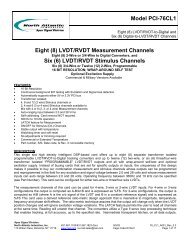Fundamentals of the Analog Computer - IEEE Xplore
Fundamentals of the Analog Computer - IEEE Xplore
Fundamentals of the Analog Computer - IEEE Xplore
Create successful ePaper yourself
Turn your PDF publications into a flip-book with our unique Google optimized e-Paper software.
F E A T U R E<strong>Fundamentals</strong> <strong>of</strong> <strong>the</strong><strong>Analog</strong> <strong>Computer</strong>Circuits, technology, and simulationBy Robert M. HoweThe analog computers created in <strong>the</strong>years immediately following WorldWar II were based on electronicversions <strong>of</strong> <strong>the</strong> mechanical differentialanalyzer, first conceived byLord Kelvin and implemented atMIT during <strong>the</strong> 1930s by Vannevar Bush. Theheart <strong>of</strong> <strong>the</strong> analog computer is <strong>the</strong> operationalamplifier, which consists <strong>of</strong> a high-gain dcamplifier with a feedback impedance Z f andinput impedances Z 1 , Z 2 , and Z 3 , as shown inFigure 1. Operational amplifiers, configured asin Figure 1, can be combined to solve lineardifferential equations with constant coefficients.Figure 2 shows how two integratingamplifiers and one summing amplifier can beinterconnected to solve a second-order massspring-dampersystem.The dc operational amplifier was first developedby Philbrick and researchers at Bell Laboratories,but later improved by Goldberg at RCA©DIGITALVISIONLaboratories with <strong>the</strong> addition <strong>of</strong> drift stabilization.U.S. government-sponsored projects for <strong>the</strong> development<strong>of</strong> analog computers for real-time simulation <strong>of</strong> flightequations included Project Cyclone at Reeves Instrument Corporation,Project Typhoon at RCA Laboratories, and <strong>the</strong> DACL(Dynamic Analysis and Control Laboratory) at MIT, while ProjectWhirlwind funded <strong>the</strong> initial development <strong>of</strong> digital computers for realtimeflight simulation at MIT.To solve differential equations with specified initial values for <strong>the</strong> state variables, it is necessaryto include initial-condition relays with <strong>the</strong> integrating amplifiers. Figure 3 illustrates <strong>the</strong> circuitfor a single integrator, which includes both a reset relay and a hold relay. When <strong>the</strong> resetrelay is energized, <strong>the</strong> amplifier input is switched from <strong>the</strong> input computing resistors to <strong>the</strong>summing junction <strong>of</strong> <strong>the</strong> two initial-condition resistors; <strong>the</strong> integrator output voltage <strong>the</strong>nassumes <strong>the</strong> value e o (0), <strong>the</strong> desired initial condition. When <strong>the</strong> reset relay is de-energized, <strong>the</strong>0272-1708/05/$20.00©2005<strong>IEEE</strong>June 2005 <strong>IEEE</strong> Control Systems Magazine29
amplifier input is reconnected to <strong>the</strong> input computingresistors, and <strong>the</strong> analog solution to <strong>the</strong> differential equationproceeds. Figure 3 also shows a hold relay that, whenInputVoltagesFigure 1. Operational amplifier. When <strong>the</strong> feedback and input impedances areresistors, <strong>the</strong> output voltage is proportional to <strong>the</strong> sum <strong>of</strong> <strong>the</strong> input voltages. Whena capacitor C is used as a feedback impedance, Z f = 1/(Cs) and <strong>the</strong> output voltageis proportional to <strong>the</strong> time integral <strong>of</strong> <strong>the</strong> sum <strong>of</strong> <strong>the</strong> input voltages.kf(t)− — dxdtf(t)− xme 1e 2e 3m/cmcm/kxZ 1 Zfi 1i fZ 2Z 3i 2i 3 e' dc AmplifierGain = −µe oLetting i 1 +i 2 +i 3 = i f and e' = − —1 e o , it follows from Ohm's Law thatµZFor <strong>the</strong> dc amplifier gain >> 1 + — f Z+ — f Zµ+ — f,Z 1 Z 2 Z 31Z f Z f Z— e fZ 1 + — e1 Z 2 + — e2 Z 33e o = ————————— .Z f Z f Z1+ 1 ⎡ — + — + — f ⎤µ –⎣1+ Z 1 Z 2 Z 3 ⎦Z f Z f Z fe o ≅ − ⎡— eZ 1 + — e1 Z 2 + — e2 Z 3⎤ .⎣3 ⎦m——d 2 x dx+ c — + kx = f(t), or ——d 2 x 1 c dx k= — f(t) − — — − —x .dt 2 dtdt 2 m m dt mResistors in megohms, capacitors in micr<strong>of</strong>arads111x− dx23—dtFigure 2. <strong>Analog</strong> circuit for simulating a mass-spring-damper system. Amplifier 1 sums<strong>the</strong> terms in <strong>the</strong> equation for d 2 x/dt 2 and integrates <strong>the</strong> sum to obtain −dx/dt. Amplifier2 integrates −dx/dt to obtain x. Amplifier 3 simply inverts x to obtain −x. Note that allintegrators are inverting.11OutputVoltage− xenergized, disconnects <strong>the</strong> amplifier input from all inputresistors. This procedure <strong>the</strong>n stops <strong>the</strong> integration andfreezes <strong>the</strong> integrator output voltage at its current value.The hold mode <strong>of</strong>fers a useful methodfor accurately reading all integratorvalues at predetermined times duringan analog solution.To solve linear differential equationswith time-varying coefficients,<strong>the</strong> author utilized a stepping relay tovary <strong>the</strong> appropriate computing resistor<strong>of</strong> an operational amplifier at afixed sample rate in time. The resistorfor each time step was chosen so that<strong>the</strong> time integral <strong>of</strong> <strong>the</strong> resistor valuematched <strong>the</strong> time integral <strong>of</strong> <strong>the</strong> correspondingcontinuous time function.Figure 4 shows a simple example, ananalog circuit for solving Bessel’sequation <strong>of</strong> order zero.In [1], examples are given <strong>of</strong> analogsolutions <strong>of</strong> <strong>the</strong> time-dependenttransient responses <strong>of</strong> one- and twodegree-<strong>of</strong>-freedommechanical systems.The transient response <strong>of</strong>simple feedback control systems,where <strong>the</strong> analog computer solutionsare recorded as a function <strong>of</strong> <strong>the</strong> independentvariable time by using adirect-inking oscillograph, is exploredas well. Also shown are <strong>the</strong> solutions<strong>of</strong> both Bessel’s and Legendre’sdifferential equations, which aresolved as second-order linearsystems with time-varying coefficientsusing <strong>the</strong> stepping-relayscheme described above (andshown in Figure 4) to approximate<strong>the</strong> variable coefficients.Solutions for <strong>the</strong> static displacement<strong>of</strong> structural beams withvarious boundary conditionsand load distributions are alsosolved by allowing time on <strong>the</strong>analog computer to correspondto distance along <strong>the</strong> beam. Thenormal-mode frequencies <strong>of</strong>both uniform and nonuniformbeams are solved as two-pointboundary-value problems, againby letting time on <strong>the</strong> analogcomputer represent distancealong <strong>the</strong> beam. Here <strong>the</strong> unknownratio <strong>of</strong> <strong>the</strong> two nonzero30 <strong>IEEE</strong> Control Systems MagazineJune 2005
initial state variables, toge<strong>the</strong>r with <strong>the</strong> unknown eigenvaluefor each mode, are varied by trial and error until <strong>the</strong>two specified end conditions are met.Stability <strong>of</strong> Operational AmplifiersBecause <strong>the</strong> operational amplifier represents a feedbacksystem with a wide choice <strong>of</strong> feedback and input impedances,it is important to consider <strong>the</strong> dynamic requirementson <strong>the</strong> amplifier gain µ(s) to ensure closed-loopamplifier stability. These requirements can be understoodby breaking <strong>the</strong> feedback loop, as shown in Figure 5, with<strong>the</strong> input impedance Z i grounded to represent zero inputvoltages. The overall open-loop transfer function is <strong>the</strong>ngiven bye o(s) =−µZ i,e ′ Z i + Z falso known as <strong>the</strong> return ratio. For <strong>the</strong> closed-loop systemto be stable, <strong>the</strong> phase shift <strong>of</strong> <strong>the</strong> open-loop system mustbe more positive than −π at <strong>the</strong> frequency <strong>of</strong> unity openloopgain, defined as <strong>the</strong> crossover frequency. To be conservative,we usually require <strong>the</strong> phase shift <strong>of</strong> <strong>the</strong>open-loop system to be equal to −π/2 at <strong>the</strong> crossoverfrequency. Clearly∣ |µ| =Z f + Z i ∣∣∣∣ Z iat <strong>the</strong> crossover frequency. If <strong>the</strong> feedback and inputimpedances are resistors, as in <strong>the</strong> case <strong>of</strong> a summingamplifier, <strong>the</strong>n <strong>the</strong> crossover frequency occurs when|µ| = R f + R iR i.−e o (0)InputComputingResistors0.10.10.111 ResetRelayHoldRelayIntegratorOutputFigure 3. Circuit for integrator mode control. The resetrelay, when energized, establishes <strong>the</strong> initial condition for<strong>the</strong> integrator. The hold relay, when energized, stops <strong>the</strong>integration and freezes <strong>the</strong> output voltage e o .If <strong>the</strong> feedback impedance is a capacitor, <strong>the</strong>n |Z f |≪|Z i |and <strong>the</strong> crossover frequency occurs when |µ| =1. Toensure that <strong>the</strong> open-loop phase shift is equal to −π/2 at<strong>the</strong> crossover frequency for all possible summer and integratorconfigurations, it follows that <strong>the</strong> phase shift <strong>of</strong> <strong>the</strong>amplifier gain µ(s) should be −π/2 or greater at all frequenciesfor which |µ| > 1. When <strong>the</strong> dc operational amplifier isa stable minimum-phase system (no zeros or poles in <strong>the</strong>right-half plane), which is indeed <strong>the</strong> case for both vacuumtubeand transistor amplifiers, a phase shift <strong>of</strong> −π/2 orgreater is realized when <strong>the</strong> slope <strong>of</strong> <strong>the</strong> log |µ| versuslog |ω| plot is greater than or equal to −6 dB/octave. Figure5 shows <strong>the</strong> resulting open-loop frequency response.An example <strong>of</strong> a more complex configuration <strong>of</strong> feedbackand input impedances is <strong>the</strong> single amplifier circuit for simulatinga second-order linear system, as shown in Figure 6.To examine <strong>the</strong> stability <strong>of</strong> this feedback system, weground <strong>the</strong> input terminal −e i , break <strong>the</strong> feedback loop asshown in <strong>the</strong> figure, and let <strong>the</strong> open-loop input be e ′ o . Thisone-amplifier circuit for simulating a second-order systemcan be used in <strong>the</strong> feedback loop <strong>of</strong> a high-gain amplifier to0.11Ce o− — dxdt− xtˆ1——d 2 x 1 dx+ – — + x = 0, or ——d 2 x 1 dx= −– — −x .dt 2 t dtdt 2 t dt11111 23x− dx —dt11− x0.750.50.250tˆt0 0.25 0.5 0.75 1.0tFigure 4. <strong>Analog</strong> circuit for solving Bessel’s equation <strong>of</strong> order zero. The variable coefficient is approximated with <strong>the</strong> staircasefunction using a stepping relay.June 2005 <strong>IEEE</strong> Control Systems Magazine31
voltage cx, where c is acoefficient that can bee o '| µ (j ω)|set between 0 and 1. The(dB)diagram <strong>of</strong> <strong>the</strong> analogZ fcircuit for simulating <strong>the</strong>e'mass-spring-damper system,shown earlier in Fig-−µe oZ iZ f + Z iure 2, is repeated in6 dB/octFigure 7 using potentiometersto representReturn Ratio = — e Z ioe o '<strong>the</strong> fixed coefficients in= Open-Loop Transfer Function 0log ω<strong>the</strong> problem. The feedbackimpedances are notshown in <strong>the</strong> operationalFigure 5. Operational amplifier frequency response. This open-loop frequency response isamplifiers in Figure 7.needed to provide 90° <strong>of</strong> phase margin for any ratio <strong>of</strong> feedback to input impedances.Instead, only <strong>the</strong> fixedinput gains (nominally one or ten)are shown, with a triangle representinga summing amplifier and a1 d 2 e triangle attached to a vertical barDifferential equation: –— —— o 2ζde+ —– —— o+ e o = keω 2idt 2 n ω n dtrepresenting an integrating amplifier.Thus, in Figure 7, amplifiers 1R 3From Kirchh<strong>of</strong>f's and Ohm's Laws:and 2 are integrators, whereasC 2 e o ' amplifier 3 is an inverter. The inputRk = –— 3, ω1R 1RInput2n = —————— ,resistors m/c and m in Figure 2 areR 1 √ ⎯⎯⎯⎯ R 3 C 1 R 2 C 2 −e1e i oreplaced in Figure 7 with coefficientOutputω nC pots 1 and 2 set at c/m and 1/m,ζ = —– [R 12 + R 3 (1 + R 2 /R 1 )C 2 ]2respectively, in both cases drivingunity gain inputs. The input resistorm/k in Figure 2 is replaced byFigure 6. Single-amplifier circuit for simulating a second-order system when e o ′ = e o.For <strong>the</strong> closed-loop system to be stable with a phase margin <strong>of</strong> π/2, <strong>the</strong> open-loop frequencyresponse should exhibit a slope <strong>of</strong> −6 dB/octave at and around <strong>the</strong> frequency driving a gain-<strong>of</strong>-ten input. Pot 4 iscoefficient pot 4, set at 0.1 c/m and<strong>of</strong> unity (0 dB) open-loop gain.used in Figure 7 to set <strong>the</strong> initialcondition x(0) on <strong>the</strong> massobtain a representation <strong>of</strong> <strong>the</strong> reciprocal <strong>of</strong> a second-order displacement, whereas <strong>the</strong>re is no indication <strong>of</strong> initialconditioncircuitry in Figure 2.system. The author utilized such a scheme to implementan electronic drive circuit for <strong>the</strong> two-channel direct-inking It should be noted that <strong>the</strong> setting <strong>of</strong> <strong>the</strong> output wiperoscillograph used for recording analog solutions. In this arm on <strong>the</strong> coefficient pot must take into account <strong>the</strong> inputcase, <strong>the</strong> recorder by itself was well represented by <strong>the</strong> resistor driven by <strong>the</strong> pot, since that input resistor is indynamics <strong>of</strong> a second-order system with an undamped naturalfrequency <strong>of</strong> approximately 30 Hz. When combined In general-purpose analog computers, <strong>the</strong> coefficient potsparallel with <strong>the</strong> pot resistance from wiper arm to ground.with <strong>the</strong> electronic drive circuitry described earlier, <strong>the</strong> are normally set in a pot-set mode, with <strong>the</strong> pot input xbandwidth <strong>of</strong> <strong>the</strong> overall recording system was extended replaced by +1 reference (that is, +100 V for analog computersbased on 100-V reference, and +10 V for analogto more than 100 Hz.computers based on 10-V reference). The pot is <strong>the</strong>n set to<strong>the</strong> desired value, ei<strong>the</strong>r by reading a digital voltmeter orby means <strong>of</strong> a null meter connected between <strong>the</strong> pot outputand a reference pot with a precision dial. Note that <strong>the</strong>coefficient pots are not set by reading <strong>the</strong> pot dials, eventhough <strong>the</strong> coefficient pots are usually ten-turn helical potswith precision, counter-type dials.It is apparent that <strong>the</strong> variables used in analog simulationsmust be properly scaled both to avoid over-rangingamplifier outputs and to ensure that amplifier outputsThe Use <strong>of</strong> Potentiometers to SetCoefficient Values in <strong>Analog</strong> SimulationsAll <strong>of</strong> <strong>the</strong> circuits described thus far for <strong>the</strong> analog solution<strong>of</strong> differential equations have utilized resistors to setsumming and integrating amplifier gains. However, a muchmore practical method for implementing <strong>the</strong> precision setting<strong>of</strong> arbitrary coefficients in analog simulations utilizespotentiometers. For example, <strong>the</strong> potentiometer shown at<strong>the</strong> top <strong>of</strong> Figure 7 with input voltage x provides an output32 <strong>IEEE</strong> Control Systems MagazineJune 2005
ange over a reasonable fraction <strong>of</strong>full-scale during any given solution.A similar problem occurs whenusing fixed-point digital computation.The simplest solution is torepresent each variable as a scaledfraction, <strong>the</strong> variable divided by itsmaximum value. Then each scaledfractionvariable will range over±1, which corresponds to ±100 Vin <strong>the</strong> case <strong>of</strong> 100-V analog computersand ±10 V in <strong>the</strong> case <strong>of</strong> 10-Vanalog computers. Actually, manyengineers (including <strong>the</strong> author)have found that <strong>the</strong> process <strong>of</strong>scaling problem variables can lendconsiderable insight into <strong>the</strong> problemitself, including <strong>the</strong> identification<strong>of</strong> dominant terms.Servomultipliers for<strong>Analog</strong> <strong>Computer</strong>sAll <strong>of</strong> <strong>the</strong> example analog simulationsdescribed thus far haveinvolved <strong>the</strong> solution <strong>of</strong> linear differentialequations, including differentialequations with timevaryingcoefficients. Figure 8shows a schematic <strong>of</strong> a typical servomultiplier.The three gangedpotentiometers at <strong>the</strong> right side <strong>of</strong><strong>the</strong> figure are driven by a twophaseinduction motor with an n:1gear reduction (not shown in <strong>the</strong>figure). The servomotor is in turndriven by a magnetic amplifier,which receives its dc input from ananalog controller unit. The error inservo output angle is given byCoefficient Pote = X in − X out , where X in is <strong>the</strong> command input angle for<strong>the</strong> servo and X out is <strong>the</strong> measured output angle, asobtained from <strong>the</strong> wiper arm output −X out <strong>of</strong> <strong>the</strong> potentiometerwith −100 V and +100 V connected to <strong>the</strong> highand low side, respectively. With ±Y and ±Z connectedacross <strong>the</strong> second and third potentiometers, <strong>the</strong> pot outputsrepresent XY and XZ, respectively. Note that <strong>the</strong> staticaccuracy <strong>of</strong> <strong>the</strong> servomultiplier depends on <strong>the</strong>linearity <strong>of</strong> each ganged pot as well as <strong>the</strong> static nullingerror <strong>of</strong> <strong>the</strong> servo.Typical pots used in servomultipliers exhibit a maximumlinearity error ranging between 0.02% for ten-turnwire-wound, ganged potentiometers to 0.1% for one-turnganged potentiometers, ei<strong>the</strong>r wire wound or film type.The static nulling error <strong>of</strong> <strong>the</strong> servomultiplier depends onxccxc/m1m——d 2 x+ c —dx+ kx = f(t), or 1/mdt 2 dt1 1 1f (t) 21 2xd 2 dxx 1 c dx k0.1k/mdt 2dtm m dt m1031Figure 7. Using potentiometers to set coefficient values in an analog simulation circuit.Note that pot 3 is set at 0.1 c/m because <strong>of</strong> <strong>the</strong> gain-<strong>of</strong>-10 input. To speed up <strong>the</strong>setting <strong>of</strong> coefficients in large problems, servo-set potentiometers were widely used instate-<strong>of</strong>-<strong>the</strong>-art analog computers.X in11−X out1−e<strong>Analog</strong>ControllerCircuitFigure 8. A servomultiplier that uses a 60-Hz, two-phase servo motor driven by amagnetic amplifier. The analog controller circuit is used to provide additional damping.Typical multiplier accuracy was 0.1% or better. Because <strong>of</strong> <strong>the</strong> limited servobandwidth, <strong>the</strong> servo input X in should be assigned to <strong>the</strong> slower <strong>of</strong> <strong>the</strong> two variablesin computing a product.ux60-Hz Ref.MagneticAmplifier<strong>the</strong> overall design <strong>of</strong> <strong>the</strong> servo, <strong>the</strong> static friction due toboth pot friction and gear-train friction, and <strong>the</strong> static resolution<strong>of</strong> <strong>the</strong> ganged potentiometers. In <strong>the</strong> case <strong>of</strong> wirewoundpotentiometers, <strong>the</strong> static resolution is equal to <strong>the</strong>reciprocal <strong>of</strong> <strong>the</strong> number <strong>of</strong> wire turns, typically 3,000 forone-turn pots and more than 10,000 for ten-turn pots. Thestatic resolution error associated with conducting-filmpots can approach zero. To preserve static accuracy in <strong>the</strong>servomultiplier, it should also be noted that it is importantfor <strong>the</strong> multiplier pots with outputs XY and XZ in Figure 8to drive input resistors that are identical with <strong>the</strong> resistorthat loads <strong>the</strong> output −X out <strong>of</strong> <strong>the</strong> reference pot (that is, 1megohm in <strong>the</strong> example shown here).The transfer function <strong>of</strong> a typical servomotor plus <strong>the</strong>magnetic amplifier driver is given byc4–1(ref)–x(0)cx60-Hz Ref.ServoMotor−1003+Y+Z+100 −Y −ZXY XZ–xJune 2005 <strong>IEEE</strong> Control Systems Magazine33
M(s) =K m/ Is 2 + s/T m, (1)Input−eR fR C 1 1ZOutput u f= =K 1+ C es1−ue Z i τs + 1R 2Where K =R fC 2R 2, C e = (R 1 + R 2 ) C 1 , C i =1R 2 C 2,Figure 9. One-amplifier analog controller circuit for proportional, bandwidth-limitedrate and integral control. Alternatively, a circuit that requires two conventionalintegrating amplifiers and two summing amplifiers can be used.YXYXYX−100−100−1002R 1a2R 1aR 1b2R 2a2R 2aR 2b2R 3a2R 3aR 3b••••i 1D 3••••iFigure 10. Diode circuit for approximating ((X + Y)/2) 2 for X + Y > 0. The same circuitis repeated with inputs −X and −Y to approximate ((X + Y)/2) 2 for X + Y < 0. A similarpair <strong>of</strong> circuits with inputs X and −Y, and −X and Y, with diodes reversed and +100 biasvoltages, is used to approximate −((X − Y)/2) 2 . A single operational amplifier is used tosum <strong>the</strong> outputs <strong>of</strong> all four circuits to produce <strong>the</strong> product XY.where I is <strong>the</strong> total inertia <strong>of</strong> <strong>the</strong> servomultiplier(including servomotor, gear train, and ganged potentiometersreferred to <strong>the</strong> servo output shaft) and T m is<strong>the</strong> motor time constant. If <strong>the</strong> analog controller circuitin Figure 8 consists <strong>of</strong> a pure gain K , <strong>the</strong>n <strong>the</strong> overallservo transfer function is approximately represented bya second-order system with an undamped natural frequencygiven by ω n = √ KK m / I and damping ratio givenby ζ = (1/2) √ I/KK m /T m . To obtain satisfactory nullingerrors, <strong>the</strong> gain constant K for typical servomultipliersmust be sufficiently large that <strong>the</strong> resulting damping ratioζ is too small for satisfactory transient performance. Thus,it is necessary to add rate control to <strong>the</strong> proportional controlin <strong>the</strong> analog controller circuit. It also may be desirableto add integral control to ensure low nulling error(that is, good servo tracking) for a slowly varying input X in .Figure 9 shows an operational amplifier circuit that provides<strong>the</strong> necessary controller transfer function, where <strong>the</strong>rate control term C e s is bandwidthlimitedby <strong>the</strong> transfer function1/(τs + 1).The overall servomultiplier transferfunction for sinusoidal inputsτ = R 1 C 1 .(1+ C i s −1 )X+Y X+Yi=i 1 ...X+Yi 2D 1+i 2 +i 3 +2D 2 i 2X+Yi 3i 1≡ −X+Yi 30.1predicts <strong>the</strong> dynamic performance<strong>of</strong> <strong>the</strong> closed-loop system based onlinear models <strong>of</strong> <strong>the</strong> subsystems.However, <strong>the</strong> servomotor has twoimportant characteristics that arenot modeled by <strong>the</strong> motor transferfunction (1). These characteristicsinclude <strong>the</strong> acceleration limit|X ′′ | max and <strong>the</strong> velocity limit |X ′ | maxfor large motor controlinputs. The experiencegained in designing servomultipliersfor analog computersled to <strong>the</strong> realizationthat <strong>the</strong> design <strong>of</strong> an electromechanicalcontrol system,2including <strong>the</strong> choice <strong>of</strong> components,is dominated bynonlinear requirements suchas <strong>the</strong> acceleration andvelocity limits (large-motionnonlinearities) and <strong>the</strong>nulling error or static resolution(small-motion nonlinearities).The role <strong>of</strong> lineardesign methods is generallylimited to <strong>the</strong> choice <strong>of</strong> controllerparameters needed toproduce satisfactory systemstability margin and transientresponse [2].O<strong>the</strong>r Nonlinear<strong>Analog</strong>-<strong>Computer</strong>ComponentsWhile <strong>the</strong> servomultipliersdescribed above were widelyutilized in analog computers34 <strong>IEEE</strong> Control Systems MagazineJune 2005
during <strong>the</strong> 1950s, several alternative, all-electronic deviceswere developed to improve <strong>the</strong> overall dynamics <strong>of</strong> analogmultipliers. The first <strong>of</strong> <strong>the</strong>se was <strong>the</strong> time-division multiplier,initially developed by Goldberg [3]. In this scheme,<strong>the</strong> voltage X is converted to a pulse-width modulated signalused to drive an electronic switch, which modulates<strong>the</strong> voltage Y. The area under each cycle <strong>of</strong> <strong>the</strong> switchedsignal is proportional to <strong>the</strong> product XY. The switched signaldrives a low-pass filter to produce a smoo<strong>the</strong>d outputXY. Although time-division multipliers achieved dynamicerrors that were typically two orders <strong>of</strong> magnitude smallerthan those associated with servomultipliers, <strong>the</strong>se multipliers<strong>of</strong>ten exhibited undesirable drift in voltage <strong>of</strong>fsetwith time. Ano<strong>the</strong>r device was <strong>the</strong> quarter-square multiplier,which was based on <strong>the</strong> equationXY = (X + Y)2 − (X − Y) 2. (2)4The circuit shown in Figure 10 is used to generate a segmentedapproximation to ((X + Y)/2) 2 for X + Y > 0.When X + Y becomes positive enough, <strong>the</strong> diode D 1 startsconducting and <strong>the</strong> current i 1starts to increase linearly forfur<strong>the</strong>r increases in X + Y. For alarger value <strong>of</strong> X + Y, diode D 2starts to conduct, and <strong>the</strong> currenti 2 starts to increase linearlywith increasing X + Y . Theoverall circuit in Figure 10 consists<strong>of</strong> n diode segments. Theamplifier output in Figure 10<strong>the</strong>n produces an n-segmentapproximation to −((X + Y)/2) 2for X + Y > 0. With idealdiodes, <strong>the</strong> segmented approximationto a quadratic function<strong>the</strong>n exhibits a maximum fractionalerror <strong>of</strong> 1/(8n 2 ). With <strong>the</strong>silicon-junction diodes normallyused for quarter-square multipliers,<strong>the</strong> nonideal diode current-voltagecharacteristicproduces additional rounding <strong>of</strong>each segment knee, fur<strong>the</strong>rreducing <strong>the</strong> quadratic-approximationerror.It should be noted that (2) for<strong>the</strong> quarter-square multiplier canbe replaced with <strong>the</strong> formulaXY = |X + Y|2 −|X − Y| 2.4XY−X−YX−Y−XYRRRRRRRRDa1By replacing (X + Y) 2 with |X + Y| 2 and replacing (X − Y) 2with |X − Y| 2 , we can eliminate <strong>the</strong> need for two <strong>of</strong> <strong>the</strong> foursegmented quadratic approximation circuits similar to <strong>the</strong>one shown in Figure 10. Fur<strong>the</strong>rmore, <strong>the</strong> calculation <strong>of</strong>|X + Y| and |X − Y| can be combined with <strong>the</strong> diode circuitfor <strong>the</strong> segmented quadratic approximation by using <strong>the</strong> circuitshown in Figure 11. Here <strong>the</strong> voltage at <strong>the</strong> junction <strong>of</strong>diodes D a1 and D a2 is proportional to |X + Y|/2, and <strong>the</strong>voltage at <strong>the</strong> junction <strong>of</strong> diodes D a3 and D a4 is proportionalto −|X − Y|/2, as indicated in Figure 11. These diode-junctionvoltages <strong>the</strong>n drive biased-diode circuits similar to <strong>the</strong>one in Figure 10 to produce segmented approximations to<strong>the</strong> quadratic function. Because <strong>of</strong> <strong>the</strong> loading effect <strong>of</strong> <strong>the</strong>biased-diode circuits on <strong>the</strong> passive absolute-value circuit inFigure 11, <strong>the</strong> effect <strong>of</strong> <strong>the</strong> nonideal diode characteristics on<strong>the</strong> rounding <strong>of</strong> <strong>the</strong> knees <strong>of</strong> <strong>the</strong> segmented approximation isincreased. This rounding in turn causes error in <strong>the</strong> segmentedapproximation to <strong>the</strong> quadratic function to be considerablyless than <strong>the</strong> value <strong>of</strong> 1/(8n 2 ) for ideal diodes, where nis <strong>the</strong> number <strong>of</strong> diode segments used for <strong>the</strong> quadraticapproximation. Thus, <strong>the</strong> completely passive quarter-squaremultiplier circuit <strong>of</strong> Figure 11, in addition to reducing by∝ X−Y2R 1b−V b1D a2 R 2aR 2b−V b1D 2• •• •∝− X−Y2• •• •R 1aR 1b+V b1R 2aR 2bFigure 11. A completely passive quarter-square multiplier circuit terminated in a singleoperational amplifier. The circuit is based on XY = (|X + Y|/2) 2 − (|X − Y|/2) 2 . Thecircuit output is connected to <strong>the</strong> summing junction <strong>of</strong> an operational amplifier with a0.1 m feedback resistor.R 1a••••••••0.1≡XYJune 2005 <strong>IEEE</strong> Control Systems Magazine35
more than a factor <strong>of</strong> two <strong>the</strong> number <strong>of</strong> required components,also is more accurate than <strong>the</strong> circuit in Figure 10 for agiven number n <strong>of</strong> diode segments. The author developed aten-segment version <strong>of</strong> this circuit in 1959.It should be noted that analog division <strong>of</strong> Y by X can beaccomplished by utilizing a multiplier in <strong>the</strong> feedback loop<strong>of</strong> an operational amplifier. With <strong>the</strong> amplifier input connectedto −Y, <strong>the</strong> multiplier input X in connected to X , <strong>the</strong>multiplier input Y in connected to <strong>the</strong> amplifier output, and<strong>the</strong> multiplier output X in Y in connected to <strong>the</strong> amplifierfeedback resistor, <strong>the</strong> amplifier output is <strong>the</strong> quotient Y/X .The generation <strong>of</strong> a function f(X ) can be accomplished inanalog computation by using a segmented approximation t<strong>of</strong>(X ). The segmented approximation can be generated usinga diode function generator, which consists <strong>of</strong> biased-diodecircuitry similar to that shown in Figure 10, with potentiometersused to set <strong>the</strong> slope and breakpoint <strong>of</strong> each diode segment.Alternatively, a servomultiplier can be used, with ntaps on one <strong>of</strong> <strong>the</strong> servo-driven pots. Padding resistors connectedbetween <strong>the</strong> taps can <strong>the</strong>n be adjusted to obtain <strong>the</strong>pot output Yf(X ), with f(X ) represented by an approximationwith n + 1 straight-line segments. Similarly, <strong>the</strong> functionssin(X ) and cos(X ) are generated ei<strong>the</strong>r by diodefunction generators or servo-driven sine-cosine pots. For adescription <strong>of</strong> <strong>the</strong>se and o<strong>the</strong>r analog components, see [4].One <strong>of</strong> <strong>the</strong> first implementations <strong>of</strong> time-optimal control wasaccomplished using biased-diode analog circuitry to represent<strong>the</strong> required nonlinear control law [5]. Also, <strong>the</strong> outputsaturation voltage characteristics <strong>of</strong> unstabilized operationalamplifiers were used to represent simple nonlinearities, suchas relay-type bang-bang controllers and Coulomb friction [6].Current Availability<strong>of</strong> <strong>Analog</strong> ComponentsIt should be noted that many <strong>of</strong> <strong>the</strong> components utilized in<strong>the</strong> early analog computers are currently available in integrated-circuitform. For example, operational amplifierswith bandwidths and drift characteristics equal to or betterthan <strong>the</strong> drift-stabilized amplifiers <strong>of</strong> two or threedecades ago are available at a fraction <strong>of</strong> <strong>the</strong> cost, with upto four amplifiers located on a single chip. Never<strong>the</strong>less,with <strong>the</strong> current and projected speed <strong>of</strong> digital-processorchips, it seems unlikely that analog computers will everagain match <strong>the</strong>ir prominent former role as a general-purposedevice for <strong>the</strong> simulation <strong>of</strong> dynamic systems.References[1] D.W. Hagelbarger, C.E. Howe, and R.M. Howe, “Investigation <strong>of</strong> <strong>the</strong>utility <strong>of</strong> an electronic analog computer in engineering problems,Aeronautical Research Center, Engineering Research Institute,Univ. Michigan, Ann Arbor, Michigan, UMM-28, Apr. 1, 1949.[2] E.O. Gilbert, “The design <strong>of</strong> position and velocity servos for multiplyingand function generation,’’ IRE Trans. Electron. Comput., vol. EC-8,no. 3, pp. 391–399, Sept. 1959.[3] E.A. Goldberg, “A high-accuracy time-division multiplier,’’ RCA Rev.,vol. 13, no. 3, pp. 265–274, Sept. 1952.[4] R.M. Howe, Design <strong>Fundamentals</strong> <strong>of</strong> <strong>Analog</strong> <strong>Computer</strong> Components.Princeton, NJ: D. van Nostrand, 1961.[5] R.M. Howe and L.L. Rauch, “Physical implementation <strong>of</strong> a torquesaturatedlinear servo with optimum step response,’” in Proc. JointAutomatic Control Conf., Cambridge, Mass. Sept. 1960.[6] R.M. Howe, “Representation <strong>of</strong> nonlinear functions by means <strong>of</strong>operational amplifiers,’’ I.R.E. Trans. Electron. Comput., vol. EC-5, pp.203–206, Dec. 1956.Robert M. Howe, one <strong>of</strong> <strong>the</strong> founders <strong>of</strong> Applied DynamicsInternational (ADI) and Pr<strong>of</strong>essor Emeritus at <strong>the</strong> University <strong>of</strong>Michigan, where he taught for 41 years. This image showsone <strong>of</strong> <strong>the</strong> latest ADI products, a distributed rtX system utilizingmultiple PCs for real-time hardware-in-<strong>the</strong>-loop simulation.Robert M. Howe (bobhowe@umich.edu) is Pr<strong>of</strong>essor Emeritus<strong>of</strong> Aerospace Engineering at <strong>the</strong> University <strong>of</strong> Michigan,where he served on <strong>the</strong> faculty for 41 years, including 15years as department chair. He received a B.S. in electricalengineering from Caltech. He received an A.B. from OberlinCollege, an M.S. from <strong>the</strong> University <strong>of</strong> Michigan, and a Ph.D.from MIT, all in physics. His interests include real-time simulation,as well as flight dynamics and control. He is <strong>the</strong> author<strong>of</strong> over 100 technical papers and one book on analog computers.He served as <strong>the</strong> first national chair <strong>of</strong> Simulation Councils,Inc., <strong>the</strong> predecessor <strong>of</strong> <strong>the</strong> Society for <strong>Computer</strong>Simulation. His many honors include <strong>the</strong> 1983 AIAA de FlorezTraining Award for Flight Simulation and <strong>the</strong> 1978 Award forMeritorious Civilian Service for “outstanding contributions inguidance and control, and flight simulation” while a member<strong>of</strong> <strong>the</strong> USAF Scientific Advisory Board. He has served as atechnical consultant to many companies. His technical societymemberships include AIAA (Associate Fellow), SCS, and<strong>IEEE</strong> (Fellow). He was a founder <strong>of</strong> Applied Dynamics International,an Ann Arbor computer company for which he continuesto consult since his retirement in 1991 from <strong>the</strong>University <strong>of</strong> Michigan. He can be contacted at 485 RockCreek Dr., Ann Arbor, MI 48104 USA.36 <strong>IEEE</strong> Control Systems MagazineJune 2005


